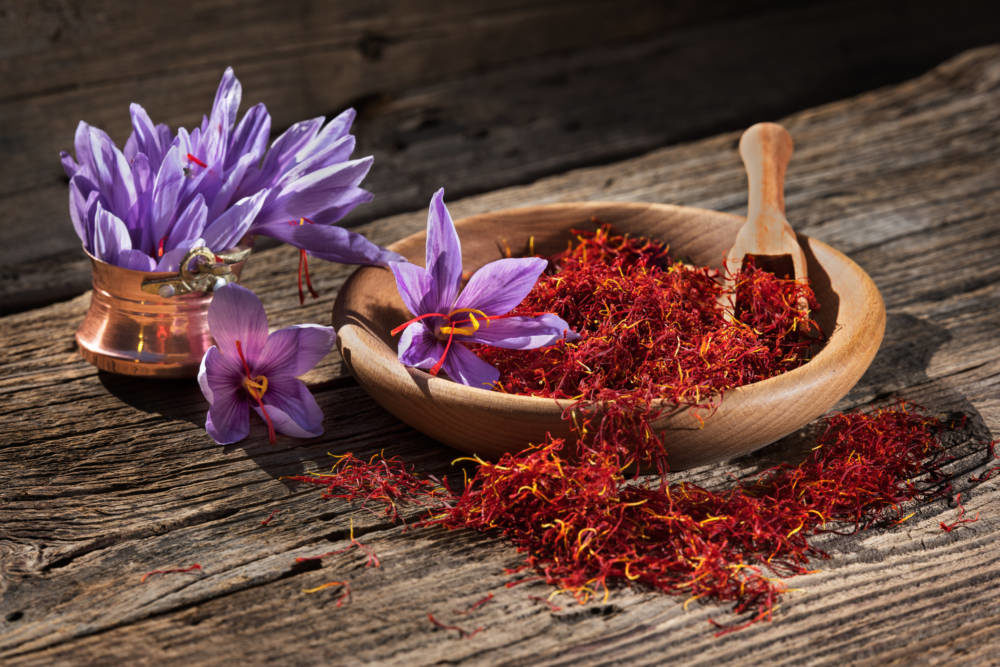Each saffron plant produces only one flower with a three-branched stigma emerging from its style, according to a press release from BAPP. The stigmas are the red-colored, thread-like parts of the female organ of the flower. Traditionally, planting, harvesting, and processing is done by hand, making it the most expensive spice in the world. Wholesale and retail saffron prices range from $500 to $5,000 per pound.
Saffron has been used mainly as a spice and a food ingredient throughout history, as well as in traditional medicine systems as a remedy for healing wounds, treating fever and lower back pain, easing digestive upset, and enhancing mood. Modern therapeutic uses of saffron extract, as supported by published clinical trial, include the relief of mild-to-moderate depression, anxiety, and stress, and there is growing evidence to support use of saffron extract for sleep.
Saffron’s high price provides economic motivation for adulteration. Adulterants include red-dyed paper strips, silk fibers, corn stigmas died in beet juice, pomegranate fruit peel or flowers, safflower and calendula flowers, and other naturally red-colored plant materials. Some adulterators have mixed powdered saffron with ground turmeric or paprika as undisclosed lower-cost bulking agents.
The BAPP bulletin was written by Stefan Gafner, Ph.D., ABC’s Chief Science officer and BAPP’s Technical Director, and four scientists working in the herbal supply industry: Aboli Girme, Ph.D., Amit Mirgal, Ph.D., and Lal Hingorani, Ph.D., from Pharmanza Herbal Pht. Ltd.; and Bhaumik Darji from Verdure Sciences. The bulletin summarizes published data on saffron stigma adulteration, lists known adulterants, provides an overview of the market and supply chains, and discusses test methods for detecting adulteration. The bulletin was peer reviewed by 20 experts in pharmacognosy and botanical ingredient analysis from academia, contract analytical laboratories, and the supplement and food industries both in the U.S. and internationally.
“Saffron is one of the most widely adulterated botanical ingredients worldwide,” commented Dr. Gafner in the press release. “Some types of adulteration are readily uncovered, even by a non-expert, for example by looking at the color of the liquid when adding saffron to hot water. Other types are more sophisticated and need state-of-the-art analytical methods for detection. This new bulletin provides much useful information about the types of saffron adulteration in the market and what specifications to consider when purchasing this botanical.”
According to BAPP partner Roy Upton, President of the American Herbal Pharmacopoeia (AHP), who is currently developing a saffron monograph and therapeutic compendium: “I only recently learned of the health-promoting benefits of saffron and have been amazed at the breadth of literature supporting its use, especially for mood. In collecting samples for analysis, we have received plastic stigmas and safflower as well as high-quality material. This makes bulletins such as this all the more valuable for informing stakeholders of the level of sophistication in the world of saffron adulteration.”
Related: BAPP Publishes Bulletin on Eleuthero ABC Introduces New Award in Honor of Steven Foster Saffron Extract May Help Support Restorative Sleep, Study Suggests
Ikhlas Khan, Ph.D., Director of the National Center for Natural Products Research (NCNPR) at the University of Mississippi, commented: “The adulteration issue related to saffron is known to all of us, but it takes a team of experts to document it scientifically and provide tools to mitigate it.”The saffron bulletin is BAPP’s 25thbulletin and 71stpeer-reviewed publication to date. As with all BAPP publications, the bulletins are freely accessible with registration on BAPP’s website.









